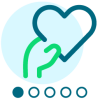Web Optimization: Keep Up With The NonProfit Web Trends Of 2017
Top 3 Trends in Nonprofit Web Design in 2017
Hi, I'm Aga from the Blackbaud Interactive Serives Team, and as a designer, I’m always looking at what’s cool and trendy in our industry. I see a lot of really great work out there and some pretty crazy ideas as well. The trick is to take inspiration from what the design community is producing and distill it into solutions that work for nonprofits and their constituents. Here are 5 website design trends that I’ve spotted so far this year:
Are you up to date on the latest web trends? Sometimes a site is one feature away from making it big--let us help you optimize your web experience with the help of Blackbaud's Interactive Services Team.
We love a good website. Take a look at some more tips and tricks for making your Arts & Cultural organization's site a click-worthy web experience. Learn More >
Hi, I'm Aga from the Blackbaud Interactive Serives Team, and as a designer, I’m always looking at what’s cool and trendy in our industry. I see a lot of really great work out there and some pretty crazy ideas as well. The trick is to take inspiration from what the design community is producing and distill it into solutions that work for nonprofits and their constituents. Here are 5 website design trends that I’ve spotted so far this year:
- Slideshows: are they a thing of the past?
Slideshows are a series of rotating images, typically found on the top half of a web page, often accompanied by messages. They have been popular for a long time and have become an expected standard on websites that their usefulness is hardly ever questioned.
I typically hear two reasons for why my nonprofit customers think they need a slideshow: they either think rotating images are cool or they think they need a slideshow to display multiple messages “above the fold”. Slideshows can be cool when used wisely with few slides and short, focused messaging paired with impactful imagery and relevant calls to action. However, in reality, a slideshow often becomes a dumping ground for all types of messages that organizations think are timely to their audiences.
Research shows that users spend just seconds on a website. Let’s think about this…a typical slideshow rotates images every 3 seconds to give the user enough time to read the text or understand the image. If you have 4 images in your slideshow you’re asking people to stay there for 12 seconds! Additionally, if we consider conversions on those slides, we can count on a certain percentage of users clicking on a link on the first or maybe even the second slide but anything beyond that will be nonexistent.
I know that sometimes organizations have a lot of important content that they want to share with users right away. What I always say is, don’t hide content if it’s important. Either find another strategic place for it on the home page or place it in a logical location in your site map. Always test to see how users interact with your content to help you make educated decisions. A good gut check is to try sitting through your own slideshow and read every message. Starting to lose interest at some point? You know what to do.
- Ambient videos and cinemagraphs
- Videos: They can either be done extremely well on websites or be a total pain to sit through. I’m sure you’ve experienced both. Silent loop videos that replace a slideshow have become more and more popular over the past few years and continue to be utilized well. When done well, they tell a story on a much deeper level very quickly. They can communicate a lot about the mission of your organization in a short amount of time. South Carolina Aquarium pairs a short silent loop video with a concise message to give users a sense of the experience. See how Memphis Zoo takes it a step further and uses their video assets as a background for their entire home page user experience. Right away, you know you’re going to have a dynamic and fun experience when visiting the zoo.
- Cinemagraph: We’ve also started seeing more cinemagraphs in web design recently. A cinemagraph is a cross between a video and a photo. Technically, it is a video clip but only has movement in a small part of the frame. Some may say that it’s purely eye candy but we know that on a nonprofit website it’s all about capturing the users’ attention. A cinemagraph, when done well, can provide us with that element of surprise without ruining user experience. Here are some examples of how cinemagraphs are being used by nonprofits. Check out the cinemagraphs posted by Pennsylvania Lumber Museum to their YouTube channel.
- Videos: They can either be done extremely well on websites or be a total pain to sit through. I’m sure you’ve experienced both. Silent loop videos that replace a slideshow have become more and more popular over the past few years and continue to be utilized well. When done well, they tell a story on a much deeper level very quickly. They can communicate a lot about the mission of your organization in a short amount of time. South Carolina Aquarium pairs a short silent loop video with a concise message to give users a sense of the experience. See how Memphis Zoo takes it a step further and uses their video assets as a background for their entire home page user experience. Right away, you know you’re going to have a dynamic and fun experience when visiting the zoo.
- Personality of content through images, typography and animation
- Images:
When you think about what gives your brand a personality, you are probably going to say the tone and voice in which your content is written or your logo and color schemes but images are a huge part of formulating that brand personality on your website. That’s why it is so important to have high quality, professional images that are relevant, strategically placed and consistent with the rest of your branding. It’s not really a trend but more of a necessity as we continue to design with the “content first” approach in 2017. Did you know that images get communicated 60,000 times faster than words? Think twice before placing an image on your site just to fill a space because you could not only ruin the message but compromise your brand. After all, we don’t get to make the first impression twice.
- Typography: Big, bold type is in! As the design world comes to the consensus that our focus should be on content, more and more websites feature lines of resonant, inspiring copy set in type that’s just as big and bold as the statement itself. “Big” and “bold” doesn’t necessarily refer to the weight of the font! Rather, it’s about dedicating significant screen real estate to a single, simple yet all-encompassing statement about your mission. Nashville Zoo does an excellent job at creating a bold and bright experience with typography that pushes their key values to the forefront.
- Animation: Something we’ve definitely seen as continuously emerging trend are subtle animations of content and I’m not talking about animated gifs or Mickey Mouse here. I’m talking about highlighting pieces of content with subtle movement. Check out the Artfields art competition and festival website on your mobile device and open their mobile menu for some fun action. This trend isn’t for everyone though. Even though technology has caught up and as designers we can consider creating animations fairly easily, we also know that users’ attention span continues to get shorter. It’s a double-edge sword sometimes and it’s best to rely on user testing to make the right call. If your brand and audiences are more conservative you may consider some more subtle animated elements or skip them all together.
- Images:
Are you up to date on the latest web trends? Sometimes a site is one feature away from making it big--let us help you optimize your web experience with the help of Blackbaud's Interactive Services Team.
We love a good website. Take a look at some more tips and tricks for making your Arts & Cultural organization's site a click-worthy web experience. Learn More >
0
Categories
- All Categories
- 6 Blackbaud Community Help
- 209 bbcon®
- 1.4K Blackbaud Altru®
- 394 Blackbaud Award Management™ and Blackbaud Stewardship Management™
- 1.1K Blackbaud CRM™ and Blackbaud Internet Solutions™
- 15 donorCentrics®
- 359 Blackbaud eTapestry®
- 2.5K Blackbaud Financial Edge NXT®
- 646 Blackbaud Grantmaking™
- 563 Blackbaud Education Management Solutions for Higher Education
- 3.2K Blackbaud Education Management Solutions for K-12 Schools
- 934 Blackbaud Luminate Online® and Blackbaud TeamRaiser®
- 84 JustGiving® from Blackbaud®
- 6.4K Blackbaud Raiser's Edge NXT®
- 3.7K SKY Developer
- 243 ResearchPoint™
- 118 Blackbaud Tuition Management™
- 165 Organizational Best Practices
- 238 The Tap (Just for Fun)
- 33 Blackbaud Community Challenges
- 28 PowerUp Challenges
- 3 (Open) Raiser's Edge NXT PowerUp Challenge: Product Update Briefing
- 3 (Closed) Raiser's Edge NXT PowerUp Challenge: Standard Reports+
- 3 (Closed) Raiser's Edge NXT PowerUp Challenge: Email Marketing
- 3 (Closed) Raiser's Edge NXT PowerUp Challenge: Gift Management
- 4 (Closed) Raiser's Edge NXT PowerUp Challenge: Event Management
- 3 (Closed) Raiser's Edge NXT PowerUp Challenge: Home Page
- 4 (Closed) Raiser's Edge NXT PowerUp Challenge: Standard Reports
- 4 (Closed) Raiser's Edge NXT PowerUp Challenge: Query
- 779 Community News
- 2.9K Jobs Board
- 53 Blackbaud SKY® Reporting Announcements
- 47 Blackbaud CRM Higher Ed Product Advisory Group (HE PAG)
- 19 Blackbaud CRM Product Advisory Group (BBCRM PAG)




